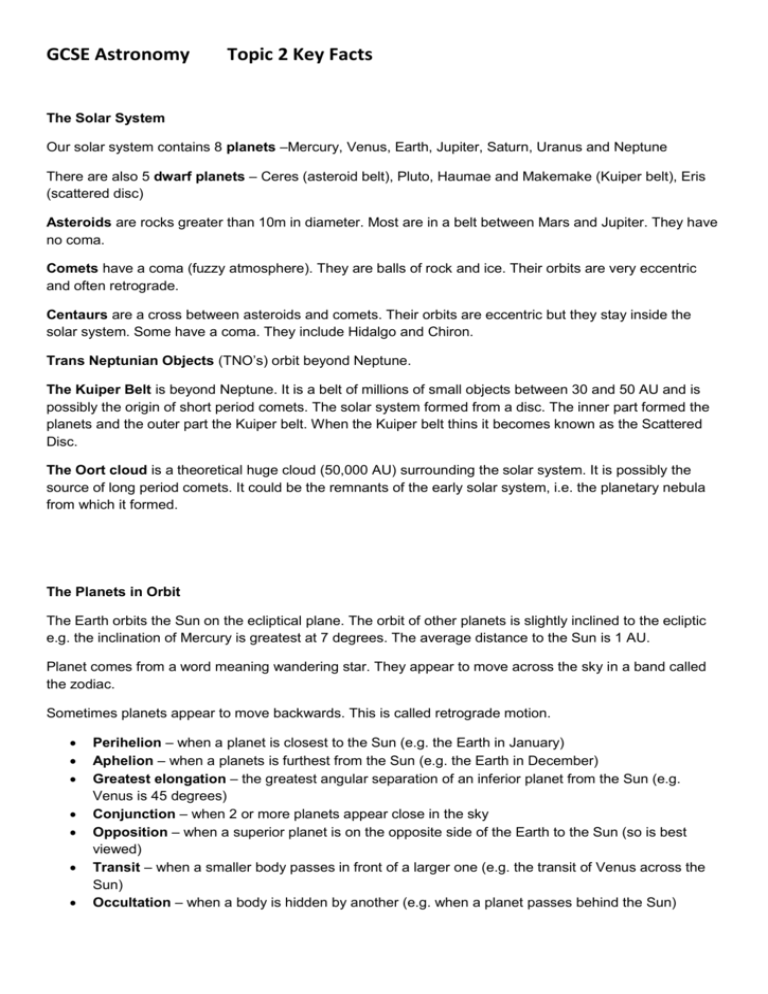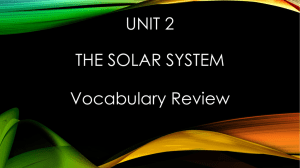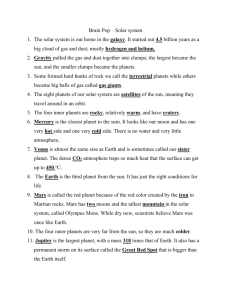GCSE Astronomy Topic 2 Key Facts
advertisement

GCSE Astronomy Topic 2 Key Facts The Solar System Our solar system contains 8 planets –Mercury, Venus, Earth, Jupiter, Saturn, Uranus and Neptune There are also 5 dwarf planets – Ceres (asteroid belt), Pluto, Haumae and Makemake (Kuiper belt), Eris (scattered disc) Asteroids are rocks greater than 10m in diameter. Most are in a belt between Mars and Jupiter. They have no coma. Comets have a coma (fuzzy atmosphere). They are balls of rock and ice. Their orbits are very eccentric and often retrograde. Centaurs are a cross between asteroids and comets. Their orbits are eccentric but they stay inside the solar system. Some have a coma. They include Hidalgo and Chiron. Trans Neptunian Objects (TNO’s) orbit beyond Neptune. The Kuiper Belt is beyond Neptune. It is a belt of millions of small objects between 30 and 50 AU and is possibly the origin of short period comets. The solar system formed from a disc. The inner part formed the planets and the outer part the Kuiper belt. When the Kuiper belt thins it becomes known as the Scattered Disc. The Oort cloud is a theoretical huge cloud (50,000 AU) surrounding the solar system. It is possibly the source of long period comets. It could be the remnants of the early solar system, i.e. the planetary nebula from which it formed. The Planets in Orbit The Earth orbits the Sun on the ecliptical plane. The orbit of other planets is slightly inclined to the ecliptic e.g. the inclination of Mercury is greatest at 7 degrees. The average distance to the Sun is 1 AU. Planet comes from a word meaning wandering star. They appear to move across the sky in a band called the zodiac. Sometimes planets appear to move backwards. This is called retrograde motion. Perihelion – when a planet is closest to the Sun (e.g. the Earth in January) Aphelion – when a planets is furthest from the Sun (e.g. the Earth in December) Greatest elongation – the greatest angular separation of an inferior planet from the Sun (e.g. Venus is 45 degrees) Conjunction – when 2 or more planets appear close in the sky Opposition – when a superior planet is on the opposite side of the Earth to the Sun (so is best viewed) Transit – when a smaller body passes in front of a larger one (e.g. the transit of Venus across the Sun) Occultation – when a body is hidden by another (e.g. when a planet passes behind the Sun) The Planets The first 4 planets are rocky. The next 4 are gas giants. Mercury – surface like our moon’s. No atmosphere. Revolves slowly so big variation in temperature. Venus – similar size to Earth. Very dense CO2 atmosphere makes the surface hotter than Mercury (acts like a blanket to keep the heat in). Show phases viewed from earth. Radar has been used to map its surface. Mars – Appears red in colour. Canyons and valleys are evidence of erosion. Very thin atmosphere mostly CO2. Jupiter – The largest planet. High velocity winds on the surface and a huge red spot. 90% hydrogen with a core of metallic hydrogen. Saturn – another gas giant. Quite squashed due to its high rotational speed. Saturn has a distinctive ring system about 1 km thick made up of particles from 1cm to 1m in size. There are 3 main regions, A and B separated by the Cassini Division then C. Uranus – spins on a very tilted axis so its south pole almost faces the Sun. Blue colour due to some methane. Was discovered by William Herschel with his powerful new telescope. Neptune – the last gas giant. Similar composition to Uranus. Its existence was predicted due to the effect of its gravity on Uranus. The origin of Moons Our moon is probably formed from the debris left by a massive impact between the Earth and another body Mars has 2 small moons, Phobos and Demos, which are probably captured asteroids Neptune’s moon Triton has a retrograde orbit. This suggests that it formed at a later time and is probably a trapped Kuiper belt object. Comets Comets have an icy rocky nucleus and a coma (visible fuzzy atmosphere). They have two tails which grow greatly in size as the comet approaches the Sun and its surface is blown away. An ion tail which always points away from the Sun due to the solar wind A dust tail which is curved as the particles in it travel slower because they are further from the Sun Comet orbits are very eccentric, often retrograde and very inclined to the ecliptic. This suggests that their origin is outside the main solar system. Meteors Meteoroid – a ball of rock in space smaller than an asteroid Meteor – one than has entered the atmosphere and is burning up leaving a fiery tail Fireball – a very bright meteor Meteorite – a meteor that lands on Earth Micrometeorites – tiny meteorites, tons of which fall on earth every day As comets orbit the Sun they leave a trail of debris. The Earth passes through some of these at the same time every year resulting in yearly meteor showers, e.g. the Leonids appear in Leo every year. A typical shower may have one meteor per minute. If we trace their paths back they all originate from the same point called the radiant. Potentially Hazardous Objects (P.H.O.s) To be potentially dangerous an object must be at least 150m in diameter and pass within 0.05 AU of Earth. There is evidence that such objects have hit earth in the past, e.g. a giant crater in Arizona. NASA have, at present, identified just over 1000 objects like these and are keeping a close eye on them. If one hit the sea it could cause a massive tsunami. NASA has observed the impacts of such bodies with Jupiter Famous Discoveries Before Copernicus people believed the Earth was the centre of the Universe. Copernicus suggested a Sun centred model which was simpler based on the available evidence Tycho took many accurate observations of the motions of stars and planets Kepler’s three laws of planetary motion (formulated mostly using Tycho’s data) 1st law - The orbit of a planet / comet about the Sun is an ellipse with the Sun at one focus 2nd law - A line joining a planet to the Sun sweeps out equal areas in equal time intervals 3rd law - The squares of the periods of the planets are proportional to the cubes of their mean distance from the Sun. If T is in years and distance in AU then T2 = R3 Galileo built his own telescope and made many important discoveries including ... Venus showed phases like the Moon (evidence that it orbits the Sun) Several moons orbit Jupiter now known as the Galilean moons (Callisto, Europa, Ganymede, Io) The surface of the Moon shows mountains and other features Other Discoveries Ceres – the first asteroid discovered by Giuseppe Piazzi Uranus – the first planet discovered using a telescope by William Herschel Neptune – its existence was predicted from irregularities in the orbit of Uranus. It was then found by Heinrich D’Arrest Pluto – its existence was wrongly predicted but then it was found by accident by Clyde Tombaugh using a photographic technique called a blink comparator Gravity All masses attract each other. The attractive force gets weaker with distance. If the distance is x 2 the force is ¼. If the distance is x 3 the force is 1/9. We call this an inverse square law. Smaller bodies orbit larger bodies due to the force of gravity. Newton first realised that it was the Earth’s gravity pulling on the Moon that kept it in orbit around the Earth. Exoplanets These are planets which orbit stars other than the Sun. They are too far to be seen directly (all stars are just points of light) but there are ways of detecting them indirectly Astometry – very accurate measurement of the position of stars may reveal “wobbles” due to the gravitational influence of large planets Doppler shifts – may also reveal stars wobbling due to the gravity of large planets Transits – the light from a star may dim periodically as a large planet crosses in front of it Life on Other Planets Life (as we know it) requires liquid water. It may have originated on Earth in several ways Comets and meteorites brought water to the prehistoric Earth (the Rosetta probe will study this) Numerous chemical reactions may have produced enough water to form oceans Bacteria may have produced water Habitable Zones are otherwise known as Goldilocks zones, they are regions around a star where the temperature is such that life could evolve on a planet in the zone The Drake Equation calculates the number of civilisations present that we may be able to communicate with. To do this it estimates * how many stars are formed * how many have planets * how many could support life * on how many does life evolve * is this life intelligent * does it develop technology * how long it survives Looking for Life Scientists listen for signals from space (The SETI program) Probes sent to planets examine samples for signs of past or present life, e.g. fossils If we discover / make contact with other life forms We may learn more about our evolution and place in the Universe, we may be able to share technologies We must be careful not to spread harmful diseases, we should hope they are friendly









